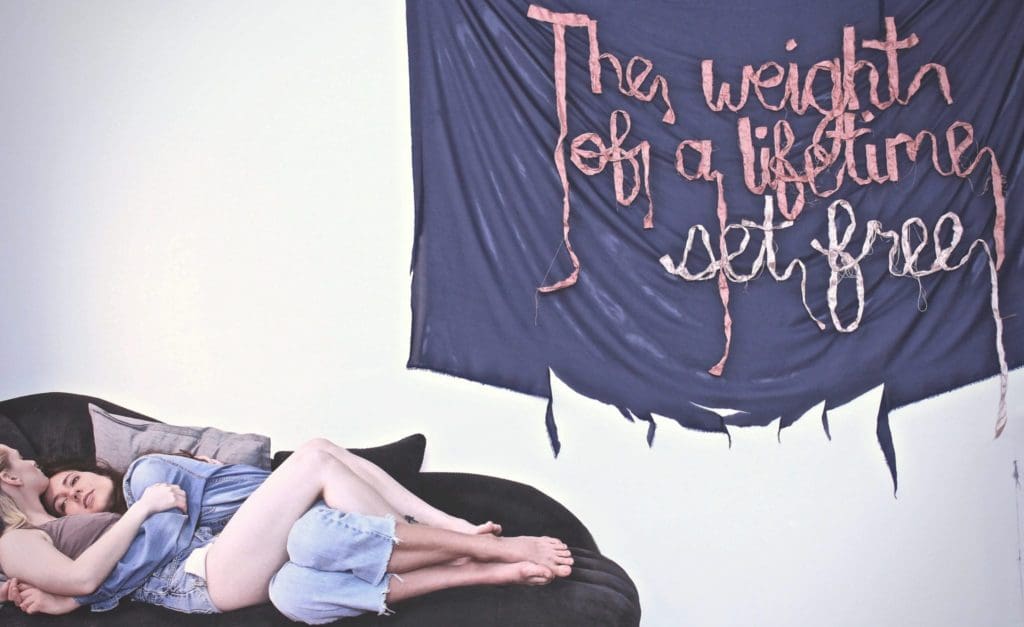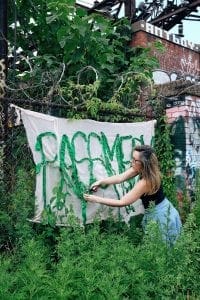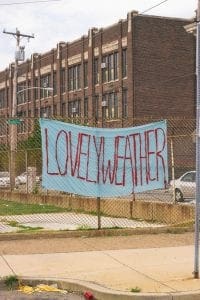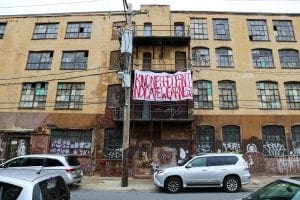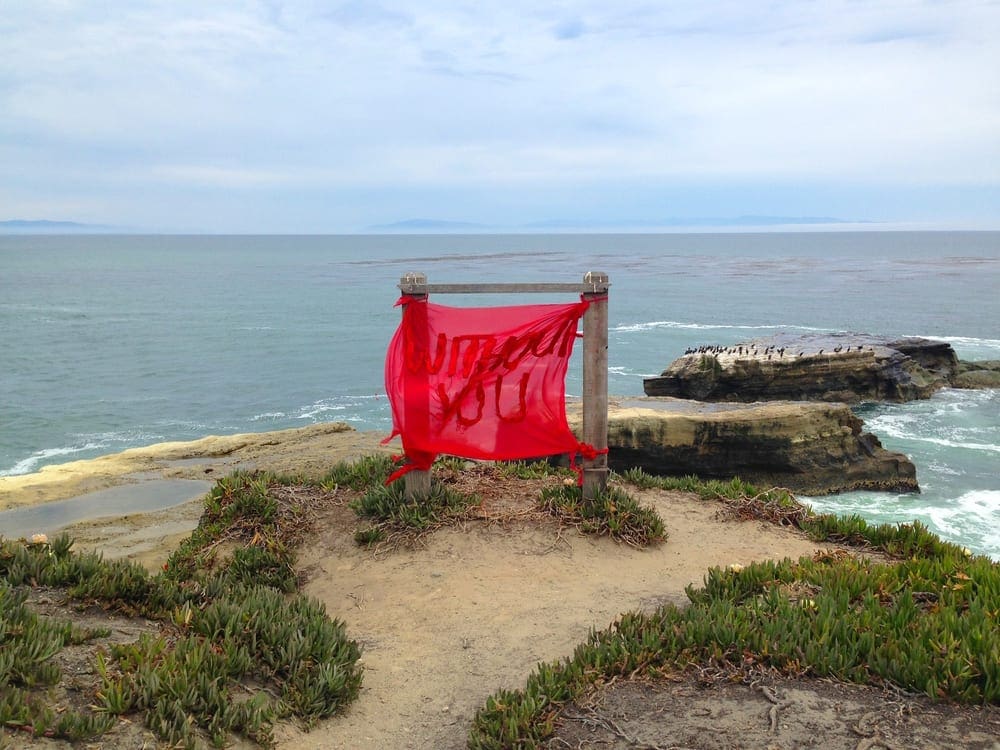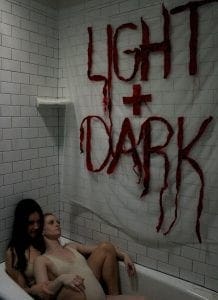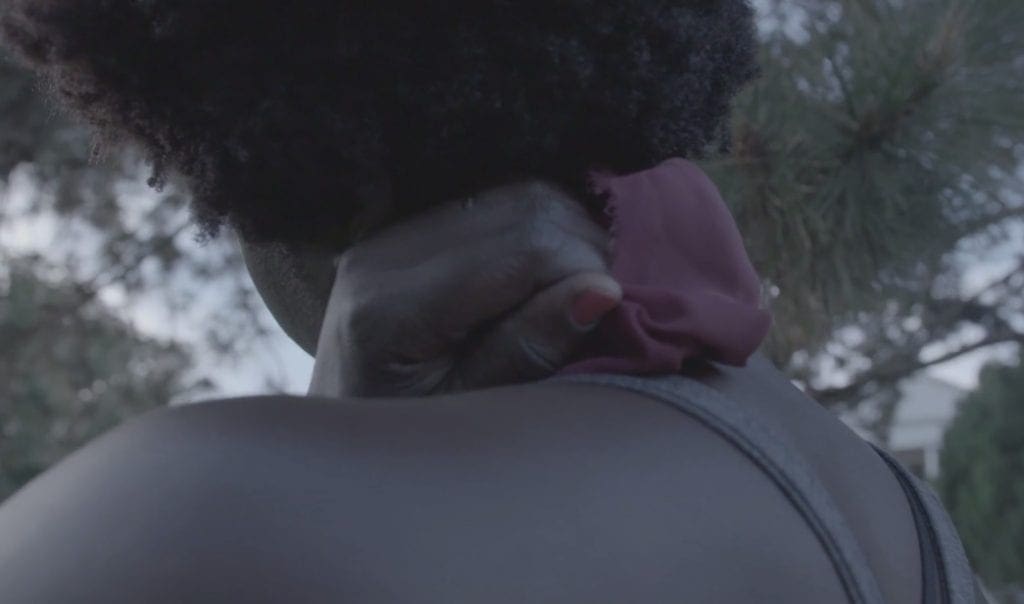Whispers from the Wall: The Silk Graffiti of Aubrie Costello
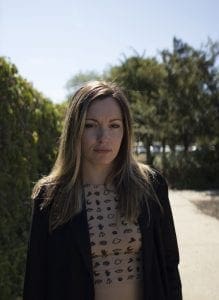 Walking down many streets in Philadelphia is like wandering an art gallery for graffiti. The tags of artists like SAGA, KAD, and LAZZ fill the walls with a calligraphy that has become a unique Philly handstyle. These, along with colorful street art projects, have made the city a vibrant center for the growth and evolution of graffiti, some even becoming three dimensional installations. You may spot some of these words made of flickering strands of fabric hanging from a wall, a fence, or a bridge. This is the work of “silk graffiti” artist Aubrie Costello, who uses long strips of Dupioni silk to write phrases around the city. Although the pieces are often large, they feel intimate, like their speaker is whispering to passersby. Some of her work is hung on the streets, while other pieces reside in nature, and others still have migrated into gallery spaces. This year, she is collaborating with dancers Jess Noel, Leslie Davidson, and Fatima Adamu in an interdisciplinary production, Show Me What You Want Me To See, or SWMYWMTS. The dance performance will take place inside a gallery with its walls covered in silk writing. An accompanying film by Lendl Tellington follows the trajectory of a romance between Jess and Leslie in the apartment of Victoria Prizzia, which is similarly filled in Aubrie’s silk calligraphy. This is interspersed with a separate story of love lost, performed by Fatima in a cemetery, as well as shots of more silk words and phrases fill a forest in the New Jersey Pine Barrens. The work is also a collaboration with composer Josh Hey, who has created ghostly and powerful original score (with a few surprise musical guests!) This interdisciplinary performance is in an intimate gallery space, accompanied by a screening of the film. The curves in the silk are mimicked in the movements of the dancers, bringing through its ephemeral but powerful emotive voice.
Walking down many streets in Philadelphia is like wandering an art gallery for graffiti. The tags of artists like SAGA, KAD, and LAZZ fill the walls with a calligraphy that has become a unique Philly handstyle. These, along with colorful street art projects, have made the city a vibrant center for the growth and evolution of graffiti, some even becoming three dimensional installations. You may spot some of these words made of flickering strands of fabric hanging from a wall, a fence, or a bridge. This is the work of “silk graffiti” artist Aubrie Costello, who uses long strips of Dupioni silk to write phrases around the city. Although the pieces are often large, they feel intimate, like their speaker is whispering to passersby. Some of her work is hung on the streets, while other pieces reside in nature, and others still have migrated into gallery spaces. This year, she is collaborating with dancers Jess Noel, Leslie Davidson, and Fatima Adamu in an interdisciplinary production, Show Me What You Want Me To See, or SWMYWMTS. The dance performance will take place inside a gallery with its walls covered in silk writing. An accompanying film by Lendl Tellington follows the trajectory of a romance between Jess and Leslie in the apartment of Victoria Prizzia, which is similarly filled in Aubrie’s silk calligraphy. This is interspersed with a separate story of love lost, performed by Fatima in a cemetery, as well as shots of more silk words and phrases fill a forest in the New Jersey Pine Barrens. The work is also a collaboration with composer Josh Hey, who has created ghostly and powerful original score (with a few surprise musical guests!) This interdisciplinary performance is in an intimate gallery space, accompanied by a screening of the film. The curves in the silk are mimicked in the movements of the dancers, bringing through its ephemeral but powerful emotive voice.
Aubrie grew up in the quiet Pine Barrens, and went to a public school where the arts were nurtured. Without much to do in their area, the kids in this town chose to make art. “There were a lot of graffiti artists, and skate kids, and musicians that are in Philadelphia now in bands. So I guess we all had that deep itch to make stuff, and now we’re in a city that is more nurturing for that.” Aubrie’s father was a woodworker, who did everything with his hands. “He would even hand draw all of his estimates and specs and documents. He didn’t do anything on a computer.” Aubrie herself absorbed the love for “do-it-yourself” aspect of a project—if given the choice, she also prefers a more analogue approach to her work. She went to the Moore College of Art and Design in 2003, where she began studying fashion design before transitioning to a major in Drawing and Painting. While she loved drawing and making her own clothes, she couldn’t enjoy the business aspect of fashion. She threw herself instead into creating art installations, and began investigating new ways of using silk. One such installation involved a huge pile of high heeled shoes, bound, or “mummified,” in silk. She would cover the gallery wall with drawings that would mirror the installation. While she was at Moore, professors would often wander into students’ studio spaces to check out their work and give them advice. One such offering was from a professor who taught fiber arts, which she had never even taken. “She came into my studio one day, and I was using silk very differently. I was stretching it on canvas stretcher bars. She said she liked it, but she said ‘You’re not letting the fabric speak for itself.’ And that was one of the things that stuck with me, I actually think about that to this day. Sometimes I want to do more to the fabric, but then I think back to what she said. The fabric alone can have its own emotive quality.”
She’s been working with fabric now for years, and lives and works on Fabric Row, the historic stretch of 4th Street in Philadelphia that has been a fabric district for generations. “I’ve been working on this street for ten years, and I buy all my fabric here, so it’s like home.” During the day, she’s an assistant buyer and manager for Bus Stop Boutique, which she originally collaborated with by installing her earlier work into the store. She loves her work as something that’s hands-on and inspiring for her projects as an artist as well. “I’m always being exposed to new color combinations, things I would never have dreamed of putting together.” It wasn’t until after college, however, that she started writing words with silk. She was doing installation work, but wanted something “strong, relatable, and tactile, without so many moving parts. The fabric was what drove it the most.” In her own work, she knew she wanted to simplify her craft—she distilled the work that she was doing down to a few basic ingredients that gave way to a whole new world of creative opportunities.
After graduation from Moore, she shared an artists’ studio with a friend and dove into her work. “I realized that I don’t like staying in studio, I wanted to go out and work on street.” Living in Philadelphia, she started to get to know the graffiti artist community, intimately learning about the history and culture of their work. She was also interested in writing, and had been collecting phrases in notebooks, sometimes from passing cars’ hip hop lyrics, other times from eavesdropping on people walking by the studio. One day, she started using extra strips of silk to write all the words that she was collecting. With some nails and without a template, she put them on the wall, and knew that this was a new direction she could go in. She had always been interested in the graffiti culture, and at the time (around 2007,) she began questioning the gender roles in what seemed like a boys club of an arts community. “When I got into school, and I started really thinking about the type of work that I wanted to make, there was a lot of gender questioning and gender role work that I was doing. The graffiti that I was exposed to at the time was this boys-club sort of graffiti.” Melding together a very “domestic” fabric and a rogue art movement, she began imitating the Philly handstyle in strips of Dupioni silk, which eventually evolved into her own handwriting. “I was trying to meld a lot of writings I was doing with graffiti that I was really drawn to, to give my own kind of spin to it.” Soon, she had escaped her studio and began bringing the pieces into the streets.
“I love street art as something that’s accessible, anybody could just stumble upon it,” says Aubrie. She began by going out in the middle of the night to tie up the words, but found that there was something about this form of street art that enabled her to go out and put them up at the middle of the day. The pieces are sewn onto a fabric background, and become a form of banner to be hung up. Instead of writing out the words first, she sews it into the fabric directly. “It’s a very fluid process, meditative way of working through it.” This intuitive process gives the words a flowing and elegant spirit. Outdoor installations are left up until they disintegrate, depending on where they are. In the city they may fall apart, or someone may take the banner. She also places her work in nature, such as in the forest or on the beach, where natural elements take the words apart over time. Her phrases respond to events in the world that surrounds them—one of the first large pieces outside was “Lovely Weather,” which she installed while there was a string of thunderstorms in the city.
The speaker and the purpose of the work has evolved as times have changed. The 2016 election spurred a new project, Signs of Solidarity. Over thirty Philadelphia artists came together to hang up banners around the city that spoke of love and acceptance, which also inspired a group of almost the same size to do continue the project in Atlanta, Georgia. She says that the experiences before the election felt like a pressure cooker, while the election was a major wake-up call that more needed to be done. She was questioning her own work, and that of others, looking at how art can be sad, comforting, and mobilizing all at once. During difficult political times like these, pieces like hers work as a place of solace. She found that she was able to change her work to something that could function as a portrait—one quote was from her close friend, who is married to an undocumented immigrant. When something happens that causes a loss for words, she finds, using someone else’s words can be key. These kind of pieces have shifted her work toward being something that’s more active and progressive. When hanging up pieces during the day, she sometimes gets reactions from people walking the streets. Many begin to ask her if she’s hanging up a memorial to someone. One of these banners was hung on the beach in Santa Cruz, reading “Without you.” Reactions from these viewers changed the way she saw her work—it could be used to memorialize something that is lost.
In SMWYWMTS, she plays into this feeling of memorial and loss. Aubrie and her friend Victoria Prizzia had a joint late-night free write, pulling words out of old journals and past writings. These eventually became the source for the words in the piece that were hung around Victoria’s apartment. She always wanted to combine her work with film, and collaborated with Lendl to record the movements of the dancers. The movements of the dancers, the lines of the words, and the strains of the original score by Josh Hey, all work together as a winding, elegant structure. The work is based on an earlier show from the dancers called Sit down. Stand up. (2015). Aubrie had seen the show, and “When they had finished, I was weeping, it was so moving.” The dancers interact with the words hung around the apartment, while Fatima Adamu does the same with the pieces hung in the Pine Barrens where Aubrie grew up. “Everyone in the film is working through a form of loss,” she says, which is the connective underlying theme. Each element has tones of both sadness and energy. Aubrie noticed a change in the font she was writing in. The letters are almost dancing, themselves, fluid in their curves. The silk moves much like the dancers, with a flowing line, but with balance and strength. The culmination is a unique and powerful collaboration that explores an underlying current in the human experience of loss.
These kinds of collaborations are what Aubrie loves about the Philly arts scene. The boutique shop window is a combination of her work and wheatpaste hearts from street artist Amberella. She’s also worked with Ishknits, a yarn bomber. Graffiti as we know it today is said to have begun in Philadelphia, and since then, the movement has grown to include many types of visual artists, many of which have moved from the shadow of anonymity into the public art world. While she throws words up onto street walls, the process and medium are different to traditional taggers. Aubrie thinks of her work as something that’s closer to site-specific installations. “I don’t really call it graffiti, but it stuck.” Graffiti and street art are often revolutionary and forward thinking—it’s not surprising that artists like Aubrie, who are switching up the game by defying expectations, are both flourishing and working together in the city. “Philly is a great place to collaborate, and I would love if we evolved toward more of that. These kinds of collaborations are really exciting, and I’m expecting to do more.” A medley of installation art, poetry, dance, and film, Show Me What You Want Me To See is just the kind of project that she hopes to continue to make.
Show Me What You Want Me To See
Aubrie Costello + Co.
$20 / 120 minutes
Philly P.A.C.K
233 Federal Street
Sept 22 at 8pm
Sept 23 at 8 pm
—Isabella Siegel
Photos: Brae Howard (“Surrender My Love,”) Aubrie Costello (“Lovely Weather,” Signs of Solidariy, “Without You,” Jess Noel and Leslie Davidson in SMWYWMTS,) Lendl Tellington (Fatima Adamu in SMWYWMTS)

